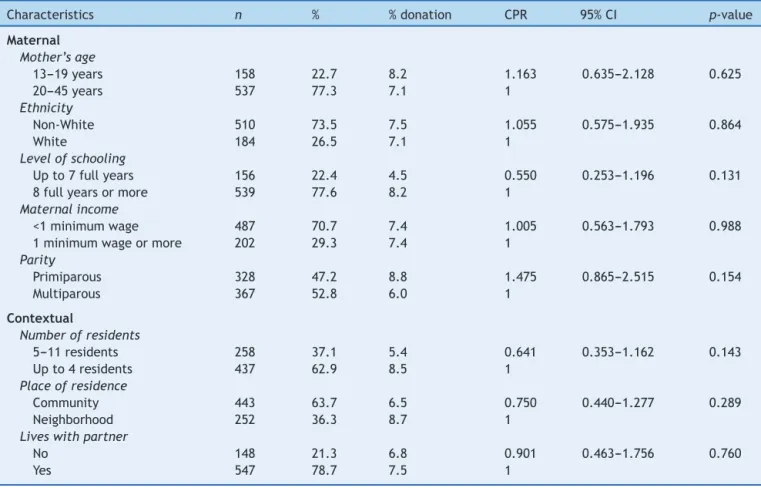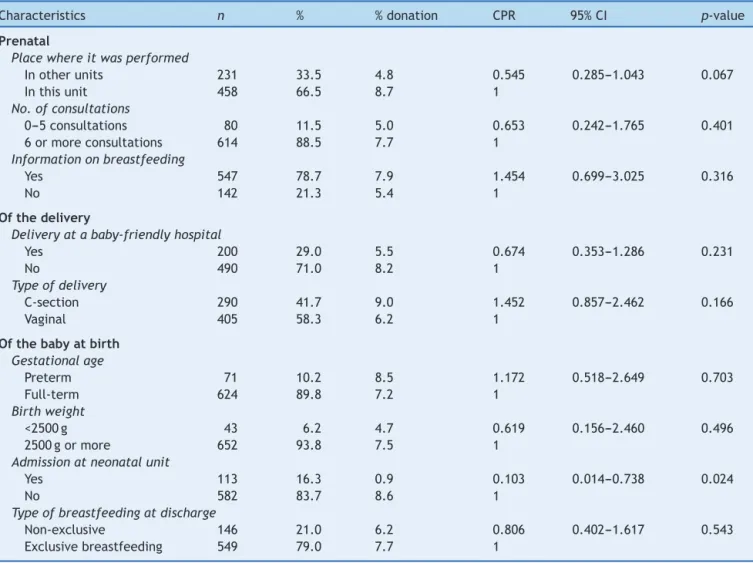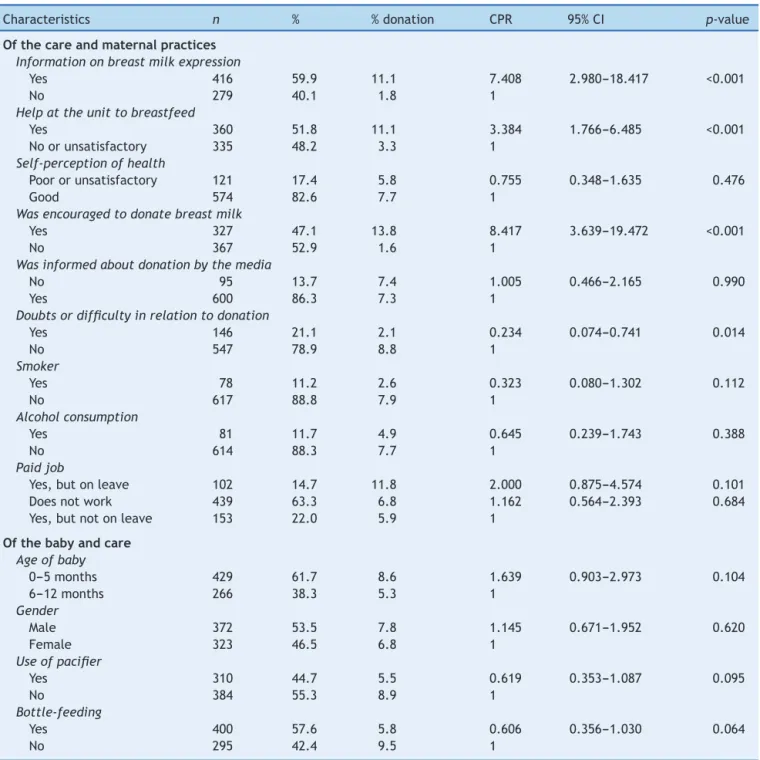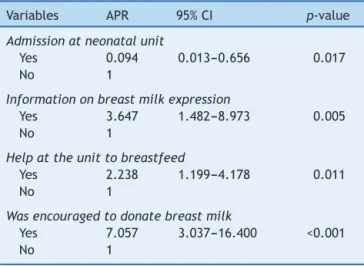www.jped.com.br
ORIGINAL
ARTICLE
Prevalence
and
factors
associated
with
breast
milk
donation
in
banks
that
receive
human
milk
in
primary
health
care
units
夽
,
夽夽
Tatiana
Mota
Xavier
de
Meneses
a,
Maria
Inês
Couto
de
Oliveira
b,∗,
Cristiano
Siqueira
Boccolini
caUniversidadeFederalFluminense(UFF),InstitutodeSaúdeColetiva,ProgramadePós-Graduac¸ãoemSaúdeColetiva,Niterói,
RJ,Brazil
bUniversidadeFederalFluminense(UFF),InstitutodeSaúdeColetiva,DepartamentodeEpidemiologiaeBioestatística,Niterói,
RJ,Brazil
cFundac¸ãoOswaldoCruz(Fiocruz),InstitutodeComunicac¸ãoeInformac¸ãoCientíficaeTecnológicaemSaúde,Laboratóriode
Informac¸ãoemSaúde,RiodeJaneiro,RJ,Brazil
Received12May2016;accepted22September2016 Availableonline19April2017
KEYWORDS
Humanmilk;
Milkbanks; Cross-sectional studies;
Primaryhealthcare; Donation;
Epidemiology
Abstract
Objective: To estimate the prevalence and to analyze factors associated with breast milk
donationatprimaryhealthcareunitsinordertoincreasethehumanmilkbankreserves.
Methods: Cross-sectionalstudycarriedoutin2013inRiodeJaneiro,Brazil.Arepresentative
sampleof695mothersofchildrenyoungerthan1yearattendedtoatthenineprimaryhealth
careunitswithhumanmilkdonationserviceswereinterviewed.Ahierarchicalapproachwas
usedtoobtainadjustedprevalenceratios(APR)byPoissonregressionwithrobustvariance.The
finalmodelincludedthevariablesassociatedwithbreastmilkdonation(p≤0.05).
Results: 7.3%ofthemothershaddonatedbreastmilk.Havingbeenencouragedtodonatebreast
milk byhealthcareprofessionals, relatives,orfriends (APR=7.06),receivinginformationon
breastmilkexpressionby theprimaryhealthcareunit(APR=3.65),andreceivinghelpfrom
theunitprofessionalstobreastfeed(APR=2.24)wereassociatedwithahigherprevalenceof
donation.Admissionofthenewborntotheneonatalunitwasassociatedwithalowerprevalence
ofdonation(APR=0.09).
夽
Pleasecitethisarticleas:MenesesTM,OliveiraMI,BoccoliniCS.Prevalenceandfactorsassociatedwithbreastmilkdonationinbanks thatreceivehumanmilkinprimaryhealthcareunits.JPediatr(RioJ).2017;93:382---8.
夽夽
StudycarriedoutatUniversidadeFederalFluminense(UFF),Niterói,RJ,Brazil. ∗Correspondingauthor.
E-mail:marinesco@superig.com.br(M.I.Oliveira). http://dx.doi.org/10.1016/j.jped.2016.09.004
Conclusions: Encouragementtobreastmilk donation,andinformationandhelpprovidedby
primaryhealth careunitprofessionalstobreastfeedingwereshowntobeimportantforthe
practiceofhumanmilkdonation.
©2017PublishedbyElsevierEditoraLtda.onbehalfofSociedadeBrasileiradePediatria.Thisis
anopenaccessarticleundertheCCBY-NC-NDlicense(http://creativecommons.org/licenses/
by-nc-nd/4.0/).
PALAVRAS-CHAVE
Leitehumano; Bancosdeleite; Estudostransversais; Atenc¸ãoprimáriaà saúde;
Doac¸ão; Epidemiologia
Prevalênciaefatoresassociadosàdoac¸ãodeleiteparapostosderecebimento deleitehumanodeunidadesbásicasdesaúde
Resumo
Objetivo: Estimaraprevalênciaeanalisarosfatoresassociadosàdoac¸ãodeleitematernoem
unidadesbásicasdesaúdecomvistasaaumentarosestoquesdosbancosdeleitehumano.
Métodos: Estudotransversalconduzidoem2013nacidadedoRiodeJaneiro,Brasil,mediante
entrevistaaumaamostrarepresentativade695mãesdecrianc¸asmenoresde1anoassistidas
nas9unidadesbásicasdesaúdecompostoderecebimentodeleitehumanoordenhado.Razões
deprevalênciaajustadas(RPa)foramobtidaspormodeloderegressãodePoissoncomvariância
robusta, segundomodelohierarquizado.Omodelofinalfoicompostopelasvariáveisquese
associaramàdoac¸ãodeleitematernoporprofissionaisdesaúde(p≤0,05).
Resultados: Doaramleitematerno7,3%dasmães.Tersidoincentivadaadoarleitematerno
porprofissionaisdesaúde,parentesouamigos(RPa=7,06),terrecebidoorientac¸ãodaunidade
básicasobreordenhadasmamas(RPa=3,65)eterrecebidoajudadaunidadebásicapara
ama-mentar(RPa=2,24)seassociaramaumamaiorprevalênciadedoac¸ão,enquantoainternac¸ão
préviadobebêemunidadeneonatalseassociouaumamenorprevalência(RPa=0,09).
Conclusões: Ficouevidenteaimportânciadoincentivoàdoac¸ão,dasorientac¸õesedaajuda
daunidadebásicaparaamamentarparaapráticadedoac¸ãodeleitematerno.
©2017PublicadoporElsevierEditoraLtda.emnomedeSociedadeBrasileiradePediatria.Este
´
eumartigoOpenAccesssobumalicenc¸aCCBY-NC-ND(http://creativecommons.org/licenses/
by-nc-nd/4.0/).
Introduction
Breastmilkis thebestfoodforthe infant;ithas species-specific nutrients and a significant number of protective factors,suchasIgA,IgM,IgG,macrophages,neutrophils,B andTlymphocytes,lactoferrin,lysozyme,andbifidfactor.1
Breastfeedingcontributestothereductionininfant mortal-ity,preventinginfectionssuchasrespiratoryanddiarrheal diseases,2,3andreducingthehospitalizationratesforthese
infections.4,5Breastmilkcompositionisadaptedtothe
new-born’s gestational age.6 Feeding premature infants with
human milk increases brain growth and intelligence quo-tients,affectingcognitivedevelopment,7,8andreducesthe
incidenceofnecrotizingenterocolitis.9Ashumanmilk
feed-ingisevenmoreimportantforat-riskneonates,theBrazilian MinistryofHealthhighlightsitsimportanceforthesurvival oftheseinfants.10
A human milk bank (HMB) is a specialized unit linked toa neonatalintensive care unit, andone of itsmissions is tostimulatethe donationofbreast milktofeedat-risk hospitalizednewborns.Theyareresponsibleforthe pasteur-izationanddistributionofhumanmilk,takingintoaccount thebaby’sneeds.However,thehumanmilkcollectedbythe HMBstilldoesnotmeetthedemandofat-risknewbornsin mostBrazilianstates,whichrecentlypromptedthe Brazil-ianMinistryofHealthtolaunchacampaigntoencouragethe donationofbreastmilk,tomeetthegoalofa15%increase inthevolumeofhumanmilkcollectedinthecountry.11
In 2007, aiming to increase breast milk reserves, an innovative experience emerged in the city of Rio de Janeiro. Healthcare professionals from a primary health care unit (PHCU), observing mothers with excess breast milk production disposing it, created a strategy called ‘‘BreastmilkexpressedReceivingServices’’,togetherwith amaternityhospitalthathadaHMB.Breastfeedingmothers wereencouragedtoexpressthebreastmilkathome,which wasthencollectedbythePHCUandsenttoanearbyHMB. In2010,thisexperiencewasincorporatedbytheMunicipal Health Secretariat of Rio de Janeiro, which opened nine milkreceivingservices,whichworktogetherwithreference HMBs.12
Thepresentstudyaimedtoestimatetheprevalenceand toanalyzethefactorsassociatedwithbreastmilkdonation toPHCUsinthecityofRiodeJaneiro.Theauthorsbelieve this study may contribute to the identification of factors associatedwithbreast milkdonation,sothatactionsthat willgenerateanincreaseintheprevalenceofsuchdonation canbeimplemented.
Methods
This was a cross-sectional study carried out in November and December of 2013 in PHCUs of the municipality. In September and October of the same year, a pilot study
was conducted in two PHCUs of the city to test the
Table1 Prevalencesandcrudeprevalenceratiosofhumanmilkdonationtoprimaryhealthcareunitsaccordingtomaternal
andcontextualcharacteristics.RiodeJaneiro,Brazil,2013.
Characteristics n % %donation CPR 95%CI p-value
Maternal
Mother’sage
13---19years 158 22.7 8.2 1.163 0.635---2.128 0.625
20---45years 537 77.3 7.1 1
Ethnicity
Non-White 510 73.5 7.5 1.055 0.575---1.935 0.864
White 184 26.5 7.1 1
Levelofschooling
Upto7fullyears 156 22.4 4.5 0.550 0.253---1.196 0.131
8fullyearsormore 539 77.6 8.2 1
Maternalincome
<1minimumwage 487 70.7 7.4 1.005 0.563---1.793 0.988
1minimumwageormore 202 29.3 7.4 1
Parity
Primiparous 328 47.2 8.8 1.475 0.865---2.515 0.154
Multiparous 367 52.8 6.0 1
Contextual
Numberofresidents
5---11residents 258 37.1 5.4 0.641 0.353---1.162 0.143
Upto4residents 437 62.9 8.5 1
Placeofresidence
Community 443 63.7 6.5 0.750 0.440---1.277 0.289
Neighborhood 252 36.3 8.7 1
Liveswithpartner
No 148 21.3 6.8 0.901 0.463---1.756 0.760
Yes 547 78.7 7.5 1
CPR,crudeprevalenceratio.
implementingexpressedhumanmilkreceivingservicesand werenotincludedinthepresentfieldwork.Thestudywas carriedoutbysixinterviewers,nursesornutritionists,and wasmonitoredbyafieldsupervisorandbytheresearchers whocoordinatedthisinvestigation.Theseinterviewerswere recruitedfromteachinginstitutionswheretheresearchers
worked and received a 20-h theoretical---practical
training.
The research data sources included questionnaires appliedtoarepresentativesample ofthemothersof chil-drenunder1yearofage,attendedtoattheninePHCUsof thecitythathadanexpressedhumanmilkreceivingservice atthetimeofthestudy.13 The motherswereaskedabout
sociodemographic characteristics, lifestyle habits, family context,carereceivedintheprenatalperiod,childbirthand mother-infant care,baby feeding,aswell asthe practice ofbreastmilk donation.Humanmilkdonation encourage-mentwasassessedbythequestion‘‘Didsomeoneencourage youtodonateyour milk?’’Theassistanceprovidedbythe PHCUtothemother-babybinomialwasinvestigatedin sev-eralways.Helptobreastfeedwasassessedbythequestion ‘‘Doyouthinkthishealthunitishelping(orhelped)youto breastfeed?’’To assess the helpreceived tolearnhow to expressmilkfromthebreasts,the followingquestion was asked:‘‘Didanyoneinthisunitexplainhowtoexpressbreast milkwithyourhandsorwiththepumpifyouneedit?’’
Datacollectionandusefollowedtheprovisionsof Resolu-tion466oftheNationalHealthCouncil(ConselhoNacional
deSaúde[CNS]).14 Datawerecollectedafteran informed
consentwassigned,andthemotherswereinformedabout thestudypurposeandthenon-mandatorynatureof partici-pation.ThestudywassubmittedtotheEthicsandResearch Committeeofthe MunicipalHealthandCivilDefense Sec-retariatandapprovedbyopinionNo.228A/2013,ofAugust 18,2013.
Theoriginalstudy,‘‘Evaluationofthefactorsassociated withbreastmilkdonationbyusersofPHCUsinthe city’’, usedasbasisforsamplesizecalculationtheprevalenceof anassessedoutcome,cross-breastfeeding,estimatedat50% based on data collected in the pilot study, resultingin a sample size of 697 mothers, considering a mean monthly demandof1321babiesunder1yearofageattendedtoat theninePHCUsthathadanexpressedhumanmilkreceiving service. Mothers weresystematicallyselectedat thetime theytooktheirchildrenunder1yearofagetoconsultations withthehealthcareteam.Datawerecollectedinallshifts ofcareateachPHCUuntilthesamplesizewasattained.13
Thissamplesizewasadequatetodetectaprevalenceratio of 1.5, witha78% test power and alphaof 5%, havingas parameter theprevalenceof7.3% ofbreastmilkdonation (outcome)foundinthedataanalysis.
Table2 Prevalencesandcrudeprevalenceratiosofhumanmilkdonationtoprimaryhealthcareunitsaccordingtoprenatal,
deliveryandbabycharacteristicsatbirth.RiodeJaneiro,Brazil,2013.
Characteristics n % %donation CPR 95%CI p-value
Prenatal
Placewhereitwasperformed
Inotherunits 231 33.5 4.8 0.545 0.285---1.043 0.067
Inthisunit 458 66.5 8.7 1
No.ofconsultations
0---5consultations 80 11.5 5.0 0.653 0.242---1.765 0.401
6ormoreconsultations 614 88.5 7.7 1
Informationonbreastfeeding
Yes 547 78.7 7.9 1.454 0.699---3.025 0.316
No 142 21.3 5.4 1
Ofthedelivery
Deliveryatababy-friendlyhospital
Yes 200 29.0 5.5 0.674 0.353---1.286 0.231
No 490 71.0 8.2 1
Typeofdelivery
C-section 290 41.7 9.0 1.452 0.857---2.462 0.166
Vaginal 405 58.3 6.2 1
Ofthebabyatbirth
Gestationalage
Preterm 71 10.2 8.5 1.172 0.518---2.649 0.703
Full-term 624 89.8 7.2 1
Birthweight
<2500g 43 6.2 4.7 0.619 0.156---2.460 0.496
2500gormore 652 93.8 7.5 1
Admissionatneonatalunit
Yes 113 16.3 0.9 0.103 0.014---0.738 0.024
No 582 83.7 8.6 1
Typeofbreastfeedingatdischarge
Non-exclusive 146 21.0 6.2 0.806 0.402---1.617 0.543
Exclusivebreastfeeding 549 79.0 7.7 1
CPR,crudeprevalenceratio.
Ahierarchicaltheoreticalmodelofthefactorsassociated withbreastmilkdonationinPHCUswascreated,comprising the distalvariables (maternal and contextual characteris-tics;Table1),intermediatevariables(characteristicsofthe prenatalcare,delivery,andofthebabyatbirth;Table2), and proximalvariables (carecharacteristics andmaternal practicesafterthebaby’sbirth,aswellascharacteristicsof thebaby;Table3).
Initially,a univariateanalysismodel wasusedtoassess the distribution of the exposure and outcome variables investigated; then, a bivariate analysis was carried out between eachexposure variableand theoutcome (breast milk donation). To obtain the prevalence ratios directly, adjustments were made using Poisson’s regression model withrobustvariance.15
The regression followed the hierarchical conceptual model,16andthevariableswereinsertedinblock.First,the
distalvariableswereanalyzed,followedbythe intermedi-atevariables,and,finally,bytheproximalvariables.Ateach stageoftheanalysis,thevariableswereadjustedinrelation totheothersatthesamelevelandtothosethatshowedan associationwithasignificancelevel≤20%inthechi-squared
test(p-value≤0.20)atpreviouslevels.
Thefinal model,usedtoestimatemeasuresof associa-tionwiththeirrespective95%confidenceintervals(95%CI), consistedoftheexposurevariablesthatobtainedan associ-ationwiththeoutcomewithanobservedsignificancelevel
≤5%(p-value≤0.05).
Results
Atotalof695mothersofchildrenunder1yearofagewere interviewedinthenineunitsthathadanexpressedhuman milkreceivingservice,and7.3%ofthemothershaddonated breastmilktothePHCUs.
In the bivariate analysis, the following variables were associatedwithhumanmilkdonation(p-value≤0.20):the
Table3 Prevalencesandcrudeprevalenceratiosofhumanmilkdonationtoprimaryhealthcareunitsaccordingtocareand
maternalpracticesafterthebaby’sbirthandbaby’scharacteristics.RiodeJaneiro,Brazil,2013.
Characteristics n % %donation CPR 95%CI p-value
Ofthecareandmaternalpractices
Informationonbreastmilkexpression
Yes 416 59.9 11.1 7.408 2.980---18.417 <0.001
No 279 40.1 1.8 1
Helpattheunittobreastfeed
Yes 360 51.8 11.1 3.384 1.766---6.485 <0.001
Noorunsatisfactory 335 48.2 3.3 1
Self-perceptionofhealth
Poororunsatisfactory 121 17.4 5.8 0.755 0.348---1.635 0.476
Good 574 82.6 7.7 1
Wasencouragedtodonatebreastmilk
Yes 327 47.1 13.8 8.417 3.639---19.472 <0.001
No 367 52.9 1.6 1
Wasinformedaboutdonationbythemedia
No 95 13.7 7.4 1.005 0.466---2.165 0.990
Yes 600 86.3 7.3 1
Doubtsordifficultyinrelationtodonation
Yes 146 21.1 2.1 0.234 0.074---0.741 0.014
No 547 78.9 8.8 1
Smoker
Yes 78 11.2 2.6 0.323 0.080---1.302 0.112
No 617 88.8 7.9 1
Alcoholconsumption
Yes 81 11.7 4.9 0.645 0.239---1.743 0.388
No 614 88.3 7.7 1
Paidjob
Yes,butonleave 102 14.7 11.8 2.000 0.875---4.574 0.101
Doesnotwork 439 63.3 6.8 1.162 0.564---2.393 0.684
Yes,butnotonleave 153 22.0 5.9 1
Ofthebabyandcare
Ageofbaby
0---5months 429 61.7 8.6 1.639 0.903---2.973 0.104
6---12months 266 38.3 5.3 1
Gender
Male 372 53.5 7.8 1.145 0.671---1.952 0.620
Female 323 46.5 6.8 1
Useofpacifier
Yes 310 44.7 5.5 0.619 0.353---1.087 0.095
No 384 55.3 8.9 1
Bottle-feeding
Yes 400 57.6 5.8 0.606 0.356---1.030 0.064
No 295 42.4 9.5 1
CPR,crudeprevalenceratio.
Itisnoteworthythat,duringthecareofferedafterthe baby’sbirth,slightlyoverhalfofthemothersreceived infor-mationattheunitonmilkexpressionandperceivedtheunit asasourceofhelpforbreastfeeding.Lessthanhalfof moth-erswereencouragedtodonatebreastmilk,encouragement camemostfrequentlyfromprofessionalsatthePHCU.Over two-thirdsofthenursingmothersdidnothavedoubtsor dif-ficultiesregardingthedonation.Mostbabieswerebottle-fed andalittlelessthan50%usedapacifier(Table3).
Inthemultivariateanalysis,thefactorsassociatedwith breastmilkdonationweretheintermediatevariable hospi-talizationofthebabyinaneonatalunit,andtheproximal
variables information on breast milk expression, having receivedhelpfromtheunittobreastfeed,andhavingbeen encouragedtodonatebreastmilk(Table4).
Discussion
Table4 Adjusted prevalenceratiosofhumanmilk
dona-tion to primary health care units. Rio de Janeiro, Brazil,
2013.
Variables APR 95%CI p-value
Admissionatneonatalunit
Yes 0.094 0.013---0.656 0.017
No 1
Informationonbreastmilkexpression
Yes 3.647 1.482---8.973 0.005
No 1
Helpattheunittobreastfeed
Yes 2.238 1.199---4.178 0.011
No 1
Wasencouragedtodonatebreastmilk
Yes 7.057 3.037---16.400 <0.001
No 1
which isstillimplementing actionstoencourage donation andtocollectbreastmilkathome.
Factorsassociatedwiththedonationwererelatedtothe assistancereceivedat thePHCUs, namely:informationon breastmilkexpression, havingbeen encouragedtodonate breast milk, and having received help from the unit to breastfeed.Onesinglefactorwasinverselyassociatedwith thedonation,thehospitalizationofthebabyinaneonatal unit.
Thisisthefirststudytoanalyzefactorsassociatedwith human milk donation by nursing mothers attended to at PHCUs,andhavingasthestudysampletheassisted popula-tion,andnotonlythedonors.Inaliteraturereviewonthe practiceofhumanmilkdonationanditsdeterminants,only twoanalyticalarticleswhoseassessedpopulationsconsisted ofhumanmilkdonorswereretrieved:oneinvestigatedthe factorsassociatedwiththeregulardonationofbreastmilk17
and the other analyzed the volume of milk donated to HMBs.18
Considering the only factor inversely associated with breast milk donation, hospitalization in a neonatal unit showed a 90% reduction in the prevalence of donation. The hospitalization of at-risk newborns negatively inter-fereswithboththedurationofbreastfeeding19andthetime
untilthefirstbreastfeeding,20possiblybecausethesucking
strengthofapretermbabyoronebornwithapathologyis lessintensethanthatofababybornatterm,21decreasing
themilkproductionstimulus.Additionally,itcanbeassumed thatchildrenwhoareadmittedtoaneonatalcareunitmay requiremorecarethanchildrenbornhealthy,making moth-erslessavailableforbreastmilkdonation.
Informationonbreastmilkexpressionduringthe follow-up at primary health units is important for breastfeeding management,sothatmotherscancopewithbreast engorge-ment or low breast milk production.22 A study conducted
in Australiaobserved thatnursing motherswhomilk their breasts areless likelytodiscontinue breastfeedingbefore the baby is 6 months old.23 Similarly, the present study
showedthatteachingmothershowtoexpresstheirmilkwas associatedwithanoverthreetimeshigherpracticeofbreast milkdonation.
The helpofferedtothenursing motherwasassociated with a two-fold higher practice of breast milk donation. Therefore,helptobreastfeed notonly contributestothe womanfeel more assured when breastfeeding,24 but also
resulted in the donation of the excess breast milk pro-duced.Aqualitativestudyobservedthat,accordingtothe mothers, breastfeeding support consists in actions avail-ableatthehospital,family,andworkplacecontextsandis aphenomenonthat encompassesaspectsofbreastfeeding encouragement,promotion,andprotection.25Astudyaimed
atunderstandingthemeaningsexpressedbywomenusersof PHCUsaboutthesupportreceivedtobreastfeedidentified encouragementaspositivesupport,aswellasmanagement andpartnershipsupport.26
Theencouragementtodonatewasthefactormostoften associatedwiththepracticeofbreastmilkdonation, possi-blyduetoitseffectsonthemother’sincentivetoexpress herownbreasts to storethe milkfor donation. However, althoughtheinterviewswerecarriedoutinunitsthathad Breastmilkexpressed Receiving Service, lessthan half of themothers had been encouragedtodonate breastmilk. Likewise,inastudycarriedoutintheFederalDistrict,the mothersdeclaredtheimportanceofhavingaccessto infor-mationonbreastfeedingontheirmotivation,but fewhad beenencouragedtodonate.27
Proximal factors, such as age and maternal schooling, werenotassociatedwithbreastmilkdonation,unlikeresults fromstudiesconductedwithdonorsforHMBs,whereyoung agewasassociatedwithahighervolumeofdonatedmilk,18
andahigherdegreeofschoolingwasassociatedwithregular donationofhumanmilk.17Inthepresentstudy,theabsence
of an association withmaternal schooling may bedue to thehomogeneity ofthe researchedpopulation asusersof theBrazilianUnifiedHealthSystem(SistemaÚnicodeSaúde [SUS]).
Thelimitationsofthepresentstudyshouldbenoted.The cross-sectional epidemiological design hinders the deter-mination of temporal---causal associations between the investigated factors and the outcome. Some results may be overestimated due to the possibility of memory bias: womenwhowerebreastmilkdonorsmayremembermore easily the incentive received at the unit for donation or help to breastfeed. It should also be noted that, in the present study,mothers were characterized asdonors and non-donors,regardless of the frequency of donations and thevolumeofdonatedmilk.Futurestudiesexploringthese aspectsmaybringnewcontributionstothesubject.
Itcan beconcludedthat theprevious admissionofthe infantto a neonatal unit had an inverse association with breastmilkdonation,andthattheincentive,help,and infor-mationprovidedtothemotherswereessentialfactorsfor breastmilkdonation,demonstratingtheroleofthePHCUs forthepromotionofthispractice.
Healthcareprofessionalsin theprimaryhealth network shouldbetrainedinbreastfeedingcounselingcourses,28the
Breastfeeding-FriendlyPrimaryCareInitiative.29and/orthe
‘‘Amamenta e AlimentaBrasil’’ Strategy.30 These training
Thesepracticeswouldcontributetotheattainmentofthe goalofa15%increaseinthevolumeofhumanmilkcollected fornewbornsatrisk,11aswellasthereductioninneonatal
mortality.9
Funding
FAPERJ,processn.E-26/111.508/20.
Conflicts
of
interest
Theauthorsdeclarenoconflictsofinterest.
References
1.Battochio AP, Santos AG, Coelho CA. Leite materno: considerac¸õessobre nutrientesespecíficoseseusbenefícios. RevBrasNutrClin.2003;18:136---41.
2.JonesG,SteketeeRW,BlackRE,BhuttaZA,MorrisSS. Bella-gioChildSurvivalStudyGroup.Howmanychilddeathscanwe preventthisyear?Lancet.2003;362:65---71.
3.GrzelakT,Wo´zniakU,Czy˙zewskaK.Theinfluenceofnatural feedingonhumanhealth:short-andlong-termperspectives. PrzGastroenterol.2014;9:4---10.
4.BoccoliniCS,CarvalhoML,OliveiraMI,BoccoliniPM.Opapeldo aleitamentomaternonareduc¸ãodashospitalizac¸õespor pneu-moniaemcrianc¸asbrasileirasmenoresde1ano.JPediatr(Rio J).2011;87:399---404.
5.Boccolini CS, BoccoliniP, deM, deCarvalhoML, de Oliveira MI.Padrõesdealeitamentomaternoexclusivoeinternac¸ãopor diarréiaentre1999e2008emcapitaisbrasileiras.CienSaúde Colet.2012;17:1857---63.
6.BarrosMD,YamashiroE,BarretoO,SampaioMM.Características doleitedemãesderecém-nascidosdebaixopeso.Pediat(São Paulo).1984;6:53---7.
7.LucasA,MorleyR,ColeTJ,ListerG, Leeson-PayneC.Breast milk and subsequent intelligence quotient in children born preterm.Lancet.1992;339:261---4.
8.Isaacs EB,FischlBR,Quinn BT,ChongWK,Gadian DG,Lucas A. Impactofbreastmilkon IQ,brainsizeand whitematter development.PediatrRes.2010;67:357---62.
9.Meinzen-Derr J, PoindexterB, Wrage L, MorrowAL, Stoll B, DonovanEF,etal.Roleofhumanmilkinextremelylowbirth weightinfants’riskofnecrotizingenterocolitisordeath.J Peri-natol.2009;29:57---62.
10.Brasil. Ministério da Saúde. Secretaria de Atenc¸ão à Saúde. DepartamentodeAc¸õesProgramáticaseEstratégicas.Atenc¸ão àsaúdedorecém-nascido:guiaparaosprofissionaisdesaúde: cuidadosgerais.Brasília:MinistériodaSaúde;2011.v.1(Série A.NormaseManuaisTécnicos);2011.
11.Brasil. Ministério da Saúde. Lanc¸ada campanha para incen-tivar doac¸ão de leite materno. Available from: http:// www.brasil.gov.br/saude/2014/05/lancada-campanha-para-incentivar-doacao-de-leite-materno[accessed13.09.16]. 12.PellegrineJB,KoopmansFF,PessanhaHL,RufinoCG,FariasHP.
Educac¸ãopopularemsaúde:doac¸ãodeleitehumanoem comu-nidadedoRiodeJaneiro,Brasil.Interface.2014;18:1499---506.
13.Von Seehausen MP, Oliveira MIC, Boccolini CS. Fatores asso-ciados ao aleitamento cruzado. Cienc Saúde Colet. 2015. Available from: http://www.cienciaesaudecoletiva.com.br/ artigos/artigoint.php?idartigo=15396[accessed13.09.16]. 14.Brasil.ConselhoNacionaldeSaúde. Resoluc¸ãon◦ 466,de12
dedezembrode2012.Dispõesobrediretrizesenormas regula-mentadorasdepesquisasenvolvendosereshumanos.Brasília.; 2012. Available from: http://www.conselho.saude.gov. br/web comissoes/conep/index.html
15.CoutinhoLM,ScazufcaM,MenezesPR.Métodosparaestimar razão de prevalência em estudos de corte transversal. Rev SaúdePublica.2008;42:992---8.
16.VictoraCG,HuttlySR,FuchsSC, OlintoMT.Therole of con-ceptualframeworksinepidemiologicalanalysis:ahierarchical approach.IntJEpidemiol.1997;26:224---7.
17.ThomazAC,LoureiroLV, OliveiraTS, MontenegroNC, Junior ED,Soriano CF,et al. Thehumanmilk donationexperience: motives,influencingfactors,andregulardonation.JHumLact. 2008;24:69---76.
18.Osbaldiston R, Mingle LA. Characterization of human milk donors.JHumLact.2007;23:350---7.
19.Gaíva MA,Gomes MM, Scochi CG, Barbeira CB. Aleitamento materno em recém-nascidos internados em UTI neonatal de um hospital universitário de Cuiabá-MT. Pediatr Mod. 2000;36:119---26.
20.Boccolini CS, Carvalho ML, Oliveira MIC, Leal MC, Carvalho MS.Fatoresqueinterferemnotempoentreonascimentoea primeiramamada.CadSaúdePublica.2008;24:2681---94. 21.KaoAP,GuedesZC,SantosAM.Característicasdasucc¸ão
não-nutritiva em RN a termo e pré-termo tardio. Rev Soc Bras Fonoaudiol.2011;16:298---303.
22.GiuglianiER.Problemascomunsnalactac¸ãoeseumanejo.J Pediatr(RioJ).2004;80:S147---54.
23.WinNN,BinnsCW,ZhaoY,ScottJA,OddyWH.Breastfeeding durationinmotherswhoexpressbreastmilk:acohortstudy.Int BreastfeedJ.2006;1:28.
24.AndréAC,GomesAL, Pinto KO,Tase TH,RuoccoRM,Santos NO,etal.Avivênciadaamamentac¸ãoem‘‘mãesdeprimeira viagem’’.Mudanc¸as-PsicologiadaSaúde.2006;14:56---73. 25.Müller FS, Silva IA. Representac¸ões sociais de um grupo de
mulheres/nutrizes sobre o apoio à amamentac¸ão. Rev Lat AmEnfermagem.2009:17.Availablefrom:http://www.scielo. br/pdf/rlae/v17n5/pt09.pdf[accessed13.09.16].
26.Oliveira MI, Souza IE, Santos EM, Camacho LA. Avaliac¸ão doapoiorecebidoparaamamentar:significados demulheres usuárias de unidades básicas de saúde do Estado do Rio de Janeiro.CienSaúdeColet.2010;15:599---608.
27.AlencarLC,SeidlEM.Doac¸ãodeleitehumano:experiênciade mulheresdoadoras.RevSaúdePublica.2009;43:70---7. 28.BrandãoEC,SilvaGR,GouveiaMT,Soares LS.Caracterizac¸ão
da comunicac¸ão no aconselhamento em amamentac¸ão. Rev EletrEnf.2012;14:355---65.Availablefrom:http://dx.doi.org/ 10.5216/ree.v14i2.12748[accessed13.09.16].
29.OliveiraMI,CamachoLA,SouzaIE.Promoc¸ão,protec¸ãoeapoio àamamentac¸ãonaatenc¸ãoprimáriaàsaúdenoEstadodoRio deJaneiro,Brasil:umapolíticadesaúdepúblicabaseadaem evidência.CadSaúdePublica.2005;21:1901---10.



